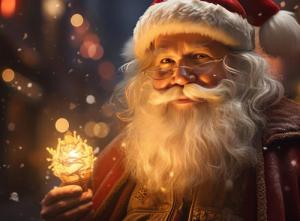Christmas and Electricity
Steve Mitnick has authored four books on the economics, history, and people of the utilities industries. While in the consulting practice leadership of McKinsey & Co. and Marsh & McLennan, he advised utility leaders. He led a transmission development company and was a New York Governor’s chief energy advisor. Mitnick was an expert witness appearing before utility regulatory commissions of six states, D.C., FERC, and in Canada, and taught microeconomics, macroeconomics, and statistics at Georgetown University.
It was the holiday season of 1880. Eleven months earlier that year, on the twenty-seventh of January, Thomas Edison had received the "electric-lamp" patent. Now, at his Menlo Park laboratory, he created a strand of lights and had them strung around the building. Visitors and those passing by were seeing the very first Christmas lights.

Christmas trees were commonly lighted, but with candles, notwithstanding the risk of fires. In 1882, Edward Johnson, who worked for Edison, strung eighty red, white, and blue electric lights around a Christmas tree at his townhouse at 136 East 36th Street in New York. Few followed his example, however. Then, a dozen years later, in 1894, President Grover Cleveland had the White House's Christmas tree decorated with multi-colored electric lights. A trend was started.
General Electric began selling pre-assembled Christmas light kits in 1903. Until then, lighting your tree electrically was expensive and the installation, complicated. But electric Christmas lights really took off in the nineteen-twenties, after Albert Sadacca vigorously marketed brightly colored and economical lights. His company virtually monopolized the market for the next few decades.
Toy electric trains, a favorite Christmas present in the twentieth century, started out as a store window display that would draw the attention of shoppers to the store. It was an idea of Harry Grant and Joshua Lionel Cowen, whose company adopted Cowen's middle name. Lionel train displays became so popular that the two men refocused their business on marketing toy trains.
Retailers still used toy trains to attract window-shopping customers, particularly at the peak retail season before Christmas. Before long, toy trains were a top seller for a present under the Christmas tree, electrically lighted of course.
Every community has a few houses whose lights during the holiday season are over the top and worthy of driving by for a look. What's the electric bill like for these spectacular displays?
Assuming the lights are on for five hours a day and for thirty days during the season, and assuming an electric rate of 11.3 cents per kilowatt-hour, one website �" christmaslightsetc.com �" figured out the electric bill for what they called the typical enthusiastic user. That is, "if cars line up outside your house to watch your display, you are classified as 'enthusiastic.'"
That enthusiastic user would be billed by its utility an extra $310.73, if the Christmas lights are incandescent bulbs. But if they're LEDs, that homeowner would be billed by its utility an extra $40.15. That's how much you save with LEDs over incandescents.
Whether you are an enthusiastic user of Christmas lights or not, indeed whether you will be celebrating Christmas or enjoying this holiday season otherwise, the Public Utilities Fortnightly team wishes you a merry break from utility regulation and policy. Those dockets will still be there when you return from the holidays.




